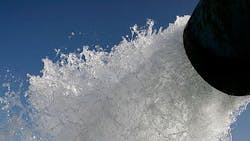Every time you turn on a faucet, a pump starts somewhere. I still remember where I heard that first, at a Plumbing Manufacturers International meeting from Gary Klein, Gary Klein & Associates, back when he was still with the California Energy Commission. Water means energy, and for some of the water distributed in California, it means a lot of energy, Klein explained, because it has to be pumped over mountains.
It takes more energy to heat that water and a lot of that is wasted, Klein pointed out, as it goes down the drain. It’s no wonder that a few firms are selling drain-water heater recovery devices.
I was reminded of that by a recent blog post from Rachel Young, national policy research analyst for American Council for an Energy Efficient Economy.
“We need energy to pump water out of the ground, treat it so it is potable, and then re-treat it after we use it to shower or wash clothes,” Young writes. “We also need energy to heat water in our homes, businesses, and industrial facilities. Recognizing these intersections opens up opportunities for utilities and businesses to save more energy and conserve more water, while helping policymakers and regulators design more strategic and cross-cutting policies.”
So how much energy do you need? According to ACEEE, source conveyance, i.e., pumping it over the mountain, takes 14,000 kWh per million gallons. Treating that water takes 16,000 kWh per million gallons. The rest of the system uses less energy — 2,000 kWh per million gallons for distribution, around 4,000 kWh for wastewater treatment and 2,000 kWh for wastewater discharge.
Ms. Young’s whitepaper, Watts in a Drop of Water: Savings at the Water-Energy Nexus, covers energy consumption of both hot and cold water in residential and commercial occupancies. Among the background reports she cites is Klein’s 2005 report for the CEC, “California’s Water-Energy Relationship.”
Inside structures, ACEEE developed a model for how much energy is used to heat water and categorized it as high, typical and low. High is the worst-case scenario — the coldest incoming water (47°F) heated to the highest output temperature (140°F) with the most inefficient water heater (a 0.52 EF gas water heater or 0.88 EF electric water heater). Heating water is the most energy intensive water related activity, much more energy intensive than anything a water utility would do. Energy consumption ranges from around 60,000 kWh per million gallons to more than 250,000 kWh per million gallons. That makes you think about flow restriction in faucets and showerheads supplied by hot water; it’s not only about the water going down the drain.
So what are the potential water savings? ACEEE cited Pacific Institute’s report, “Waste Not, Want Not: The Potential for Urban Water Conservation in California (Gleick, Haasz, and Henges-Jeck 2003), that posited that indoor water consumption could be cut by 50% if all conservation measures were put into use. But they won’t be. So ACEEE figured on 60% adoption, cutting indoor water use by 30%.
Citing an American Water Works Association study that 70% of treated water is used indoors, ACEEE estimates that 25% of that water is heated, based on numbers from the Energy Information Administration, EPA’s WaterSense program, and AWWA. Ms. Young writes that ACEEE was a tad surprised at the 25% number, thinking it would be higher.
And the energy impact? Pretty stunning. Remember that the savings ripple all the way through the system. A gallon that doesn’t come out of your showerhead is a gallon not pumped over the mountain. Thirty percent savings in hot water energy efficiency totals up to 39,000 million kWh, starting with source conveyance, treatment and distribution all the way through to the electricity or gas used inside the structure to heat water, and out through wastewater collection, treatment and discharge. On the cold-water side, a 30% reduction in water use would save 14,900 million kWh. Remember that we use cold water 3:1 to hot water, so the bulk of the savings in conveyance, treatment and distribution come from the cold water side.
Pretty compelling numbers. Contractors should remind customers that saving water is saving them gas or electricity, along with pumping energy needed in occupancies such as multi-family housing or hotels.
I tweet occasionally on that Twitter thing @bobmader
About the Author
Robert Mader Blog
Editor in Chief
Bob Mader is the editor of CONTRACTOR magazine, Green Mechanical Contractor magazine, and Radiant Living magazine. He has been writing about plumbing, mechanical, green building and HVACR topics for more than 25 years.
